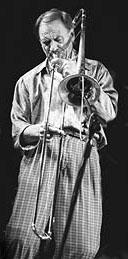Albert Mangelsdorff
| Albert Mangelsdorff | |
|---|---|

Mangelsdorff in concert
|
|
| Background information | |
| Born |
September 5, 1928 Frankfurt, Germany |
| Died | July 25, 2005 (aged 76) Frankfurt |
| Genres | Jazz |
| Occupation(s) | Musician |
| Instruments | Trombone |
| Years active | 1948–2005 |
| Associated acts | Hans Koller |
Albert Mangelsdorff (September 5, 1928 in Frankfurt, Germany – July 25, 2005 in Frankfurt) was one of the most accredited and innovative trombonists of modern jazz who became famous for his use of multiphonics.
Mangelsdorff was born in Frankfurt. He was given violin lessons as a child and was self-taught on guitar in addition to knowing trombone. His brother, alto saxophonist Emil Mangelsdorff, introduced him to jazz during the Nazi period (a time when it was forbidden in Germany). After the war Mangelsdorff worked as a guitarist and took up trombone in 1948.
In the 1950s Mangelsdorff played with the bands of Joe Klimm (1950–53), Hans Koller (1953–54) (featuring Attila Zoller), Jutta Hipp (1954–55), as well as with the Frankfurt All Stars (1955–56). In 1957 he led a hard bop quintet together with Joki Freund which was the nucleus of the Jazz-Ensemble of Hessian Broadcasting (with Mangelsdorff as its musical director until 2005). In 1958 he represented Germany in the International Youth Band appearing at the Newport Jazz Festival. In 1961 he recorded with the European All Stars (further recording in 1969). In the same year he formed a quintet with the saxophonists Heinz Sauer, Günter Kronberg, and bassist Günter Lenz and drummer Ralf Hübner which became one of the most celebrated European bands of the 1960s. In 1962 he also recorded with John Lewis ("Animal Dance"). After touring Asia on behalf of the Goethe-Institut in 1964 his quintet recorded the album "Now Jazz Ramwong" later that year which made use of Eastern themes. He also toured the USA and South America with the quintet. After Mangelsdorff's involvement in the European free jazz movement Kronberg left and the quartet remained (1969–71).
During the early seventies the quartet was revived with Sauer, Buschi Niebergall and Peter Giger (1973–76). At the same time Mangelsdorff was exploring the new idiom with Globe Unity Orchestra, but also with many other groups (e.g. the trio of Peter Brötzmann). At that time, thanks to Paul Rutherford, he discovered multiphonics, long solistic playing and experimental sounds.
...
Wikipedia
